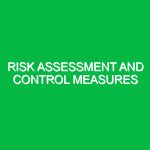In the ever-evolving landscape of workplace safety, the term Safety Performance Metrics stands out as a crucial element for organizations committed to Health, Safety, and Environment (HSE) excellence. These metrics serve as the backbone of safety management systems, providing quantifiable data that help organizations gauge their safety performance, identify areas for improvement, and ultimately cultivate a culture of safety. But what exactly are these metrics, and why do they matter? In this article, we will delve into the definition, relevance, potential hazards, best practices, and regulatory frameworks surrounding Safety Performance Metrics.
Defining Safety Performance Metrics
Safety Performance Metrics are specific measurements used to evaluate the effectiveness of an organization’s safety management practices. They encompass a wide range of indicators, from incident rates and near misses to training completion rates and safety audits. By collecting and analyzing these data points, organizations can assess their safety culture, pinpoint weaknesses, and implement targeted interventions.
For instance, consider a manufacturing plant that tracks its Total Recordable Incident Rate (TRIR). This metric reveals how many workplace injuries occur per 100 employees over a given period. By monitoring this data, the plant can identify trends, such as an uptick in injuries during specific shifts or among particular job roles, and take proactive measures to address these issues.
Relevance of Safety Performance Metrics in HSE
The relevance of Safety Performance Metrics extends beyond mere compliance with legal regulations. They enable organizations to foster a proactive safety culture that prioritizes employee well-being and operational efficiency. Moreover, effective use of these metrics can lead to substantial cost savings by minimizing workplace accidents, reducing workers’ compensation claims, and enhancing employee morale.
From a strategic perspective, Safety Performance Metrics align with broader organizational goals. For instance, a company aiming for operational excellence can integrate safety metrics into overall performance indicators. This holistic approach ensures that safety is not treated as an isolated function but as an integral part of the organization’s success.
Identifying Hazards and Risks Associated with Safety Performance Metrics
While Safety Performance Metrics are essential for promoting safety, they are not without their challenges. The very process of collecting and analyzing safety data can introduce potential hazards and risks. Below are some common pitfalls:
Data Misinterpretation
One of the most significant risks associated with Safety Performance Metrics is the potential for data misinterpretation. For example, a company might report a lower incident rate and mistakenly believe that its safety program is effective. However, this could stem from underreporting incidents, creating a false sense of security. To avoid this, organizations should foster an environment where employees feel safe reporting incidents without fear of retribution. The more accurate the data, the more reliable the metrics.
Overemphasis on Quantitative Metrics
Another hazard is an overreliance on quantitative metrics at the expense of qualitative insights. While numbers like TRIR and Lost Time Incident Rate (LTIR) provide valuable information, they do not capture the full picture of workplace safety. A near-miss incident might not result in injury but can reveal critical safety gaps. Therefore, organizations should complement quantitative metrics with qualitative assessments, such as employee feedback and safety audits, to gain a comprehensive understanding of their safety landscape.
Neglecting Leading Indicators
Leading indicators, such as the number of safety training sessions conducted or safety audits completed, can provide foresight into potential safety issues. Focusing solely on lagging indicators (like accidents that have already occurred) can lead organizations to react too late. For example, a construction company that tracks only accidents might overlook the importance of regular safety training sessions, which can significantly reduce the likelihood of incidents. Thus, a balanced approach that includes both leading and lagging indicators is essential.
Best Practices and Safety Precautions for Effective Safety Performance Metrics
To leverage Safety Performance Metrics effectively, organizations should adopt certain best practices. Here are actionable strategies to enhance safety performance:
1. Establish Clear Goals and Objectives
Organizations should define clear safety goals that align with their overall business objectives. For instance, a logistics company might aim to reduce its TRIR by 20% over the next year. By setting specific targets, organizations can focus their efforts and measure progress more effectively.
2. Foster a Culture of Safety Reporting
Encouraging employees to report near misses and unsafe conditions without fear of punishment is vital. Implementing anonymous reporting systems can help in this regard. A case study from a large oil and gas company revealed that after introducing an anonymous reporting mechanism, the number of reported near misses increased significantly, enabling the company to address potential hazards before they resulted in incidents.
3. Regular Training and Education
Continuous training ensures that employees are aware of safety protocols and best practices. Companies should invest in regular safety training sessions tailored to the specific hazards of their industry. For example, a warehouse might conduct monthly sessions on proper lifting techniques to prevent musculoskeletal injuries. By keeping safety at the forefront of employees’ minds, organizations can reduce the likelihood of accidents.
4. Utilize Technology for Data Collection and Analysis
Employing technology can streamline the process of collecting and analyzing safety data. Using software solutions that offer real-time reporting and analytics can help organizations track their safety performance efficiently. For instance, a construction firm might use wearable devices to monitor workers’ exposure to hazardous conditions, allowing for immediate corrective actions.
5. Engage Employees in Safety Initiatives
Involving employees in safety initiatives fosters ownership and accountability. Create safety committees that include representatives from various departments to discuss safety challenges and solutions. For example, a manufacturing facility might establish a safety committee that meets monthly to review incident reports and suggest improvements. This collaborative approach leads to a more robust safety culture.
Regulations and Standards Governing Safety Performance Metrics
Several regulations and standards govern the use of Safety Performance Metrics across various industries. Understanding these guidelines is crucial for compliance and effective safety management:
OSHA Regulations
In the United States, the Occupational Safety and Health Administration (OSHA) sets forth regulations that require employers to maintain records of workplace injuries and illnesses. OSHA also mandates the reporting of certain incidents, which directly impacts Safety Performance Metrics. Organizations must familiarize themselves with these regulations to ensure compliance and avoid penalties.
ISO 45001 Standard
The ISO 45001 standard provides a framework for occupational health and safety management systems. It emphasizes the importance of performance metrics in achieving safety goals and improving workplace safety. Organizations that adopt ISO 45001 can enhance their safety management systems and demonstrate their commitment to employee safety.
Industry-Specific Guidelines
Many industries have their own safety guidelines and standards. For instance, the construction industry adheres to the guidelines set by the National Institute for Occupational Safety and Health (NIOSH) and the American National Standards Institute (ANSI). Familiarity with these industry-specific standards can help organizations tailor their Safety Performance Metrics to meet the unique challenges of their sector.
Conclusion
In summary, Safety Performance Metrics are indispensable tools for promoting workplace safety in the Health, Safety, and Environment domain. By understanding their relevance, identifying potential hazards, implementing best practices, and adhering to regulations, organizations can cultivate a proactive safety culture that protects employees and enhances operational efficiency. As we move forward, it is crucial to recognize that safety metrics are not merely numbers; they embody the commitment to creating safer workplaces for everyone. By embracing these metrics, organizations not only comply with regulations but also invest in their most valuable asset: their people.


